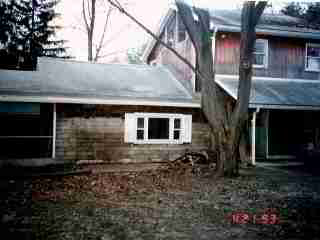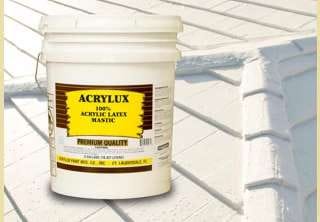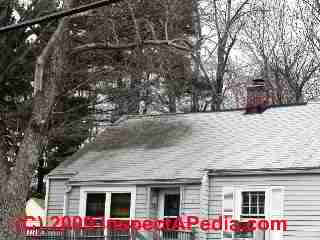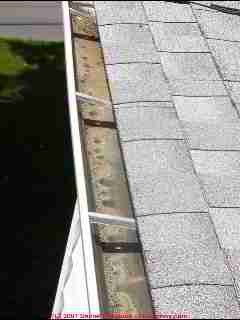 White Roof Color
White Roof Color
Benefits of white / light colored roofing
- POST a QUESTION or COMMENT about choosing the color for a roof and the effect of roof color on building cooling load
Choosing a white roof color:
Roof color can have a positive or negative impact on building energy efficiency, the service life of the roof, and on the environment.
This article series describes the effect of roof color on shingle (or other roofing material) life and the effect of roof color on building cooling load. We include a table of the effects of various roof colors on building cooling loads and costs.
InspectAPedia tolerates no conflicts of interest. We have no relationship with advertisers, products, or services discussed at this website.
- Daniel Friedman, Publisher/Editor/Author - See WHO ARE WE?
White Roof Color & Effect on Energy Use & Roof Shingle Life
 Matt Smith Arizona Roofing Systems
Matt Smith Arizona Roofing Systems
White Roof Effect on Building Heat Gain
A white roof surface or a white painted-on roof coating has a very high solar reflectance index (SRI), as high as 90 %.
Another important aspect is the thermal emittance of white roofing: white roof surfaces emit 100 % of the absorbed heat, helping to maintain a more-stable, cooler temperature inside the building.
By emitting un-wanted solar heat gain, a white roof will increase the building's energy efficiency, reduce roof surface temperatures, reduce energy cost and utility bills and extend the roof's service life.
In a neighborhood where most building roof surfaces are black or dark in color, the collective heat collection results in an urban heat island that affects the local climate. In contrast, where most roofs are light in color, the urban heat island effect is reduced. (Grimmond 1994).
In some climates, lower heat-island temperatures reduce the level or frequency of smog. (Akbari 2005)
The albedo of a city may be increased at minimal cost if high-albedo surfaces are chosen to replace darker materials during routine maintenance of roofs and roads. (Akbari 2001)
To the extent that a white roof reduces the transmission of heat to the building interior, in a cooling climate a result is a decreased usage of air conditioning. In turn that lower cooling cost cuts the building's energy cost and also reduces its carbon footprint.
Discussing their Shasta White ENERGY STAR® rated shingles, Owens Corning points out that the actual energy savings will vary depending on the geographic location of your building as well as on individual building characteristics. (Ownes Corning 2017).
White Roof Life & Warranty
 In my experience and opinion, with all other conditions such as installation details, roof slope, climate, exposure, and ventilation are the same, white roofs should have a longer life than dark roofs of the same material - perhaps twice as long.
In my experience and opinion, with all other conditions such as installation details, roof slope, climate, exposure, and ventilation are the same, white roofs should have a longer life than dark roofs of the same material - perhaps twice as long.
However roof shingle warranties, more recently often called not a warranty but a "declaration of performance", are issued by manufacturers by specific shingle product or type, not by shingle color. The words "white" or "color" do not appear in shingle warranties that we examined. (Owens Corning 2017).
See WARRANTIES for ROOF SHINGLES
Reader note: Bretz, writing with Akbari (1998) point out that
Since incoming solar radiation has a large non-visible component, solar-reflective materials can also be produced in a variety of colors.
Those authors also tell us that even dark colored roofs can include solar-reflective materials to obtain part of the environmental and cooling cost benefit of white roofs - Editor.
Watch out: stains on white roofs reduce their effectiveness at reflecting un-wanted heat, particularly in the urban environment. (Cheng 2012)
While trees close to a building may benefit its cooling cost by their shade, if trees drop leaves and debris onto a roof leading to its stain or discoloration, there may also be a loss of roof solar heat reflection in other seasons. Further, debris on roofs reduces shingle life.
More about these concerns is at DEBRIS STAINS on ROOFS.
Research on The Benefits of White Roofing
- ROOF COLOR RECOMMENDATIONS - Roof Shingle Color Advice for Northern Climates Compared with Hot High-Sun Climates
- Akbari, H., & Matthews, H. D. (2012). Global cooling updates: reflective roofs and pavements. Energy and Buildings, 55, 2-6.
Abstract:
With increasing the solar reflectance of urban surfaces, the outflow of short-wave solar radiation increases, less solar heat energy is absorbed leading to lower surface temperatures and reduced outflow of thermal radiation into the atmosphere.
This process of “negative radiative forcing” effectively counters global warming. Cool roofs also reduce cooling-energy use in air conditioned buildings and increase comfort in unconditioned buildings; and cool roofs and cool pavements mitigate summer urban heat islands, improving outdoor air quality and comfort.
Installing cool roofs and cool pavements in cities worldwide is a compelling win–win–win activity that can be undertaken immediately, outside of international negotiations to cap CO2 emissions.
We review the status of cool roof and cool pavements technologies, policies, and programs in the U.S., Europe, and Asia. We propose an international campaign to use solar reflective materials when roofs and pavements are built or resurfaced in temperate and tropical regions. - Akbari, Hashem, Ronnen Levinson, William Miller, and Paul Berdahl. "COOL COLORED ROOFS TO SAVE ENERGY AND IMPROVE AIR QUALITY" [PDF] Lawrence Berkeley National Laboratory (2005).
Abstract Excerpts:
Urban areas tend to have higher air temperatures than their rural surroundings as a result of gradual surface modifications that include replacing the natural vegetation with buildings and roads. The term “Urban Heat Island” describes this phenomenon.
The surfaces of buildings and pavements absorb solar radiation and become extremely hot, which in turn warm the surrounding air. Cities that have been “paved over” do not receive the benefit of the natural cooling effect of vegetation. As the air temperature rises, so does the demand for air-conditioning (a/c).
This leads to higher emissions from power plants, as well as increased smog formation as a result of warmer temperatures.
In the United States, we have found that this increase in air temperature is responsible for 5– 10% of urban peak electric demand for a/c use, and as much as 20% of population weighted smog concentrations in urban areas. - Akbari, Hashem, Melvin Pomerantz, and Haider Taha. "Cool surfaces and shade trees to reduce energy use and improve air quality in urban areas." Solar energy 70, no. 3 (2001): 295-310.
Abstract:
Elevated summertime temperatures in urban ‘heat islands’ increase cooling-energy use and accelerate the formation of urban smog.
Except in the city’s core areas, summer heat islands are created mainly by the lack of vegetation and by the high solar radiation absorptance by urban surfaces. Analysis of temperature trends for the last 100 years in several large U.S. cities indicate that, since 1940, temperatures in urban areas have increased by about 0.5–3.0°C.
Typically, electricity demand in cities increases by 2–4% for each 1°C increase in temperature. Hence, we estimate that 5–10% of the current urban electricity demand is spent to cool buildings just to compensate for the increased 0.5–3.0°C in urban temperatures.
Downtown Los Angeles (L.A.), for example, is now 2.5°C warmer than in 1920, leading to an increase in electricity demand of 1500 MW. In L.A., smoggy episodes are absent below about 21°C, but smog becomes unacceptable by 32°C.
Because of the heat-island effects, a rise in temperature can have significant impacts. Urban trees and high-albedo surfaces can offset or reverse the heat-island effect.
Mitigation of urban heat islands can potentially reduce national energy use in air conditioning by 20% and save over $10B per year in energy use and improvement in urban air quality.
The albedo of a city may be increased at minimal cost if high-albedo surfaces are chosen to replace darker materials during routine maintenance of roofs and roads. Incentive programs, product labeling, and standards could promote the use of high-albedo materials for buildings and roads. Similar incentive-based programs need to be developed for urban trees. - Berdahl, Paul, Hashem Akbari, Ronnen Levinson, and William A. Miller. "Weathering of roofing materials–an overview." Construction and Building Materials 22, no. 4 (2008): 423-433.
Abstract:
An overview of several aspects of the weathering of roofing materials is presented. Degradation of materials initiated by ultraviolet radiation is discussed for plastics used in roofing, as well as wood and asphalt.
Elevated temperatures accelerate many deleterious chemical reactions and hasten diffusion of material components. Effects of moisture include decay of wood, acceleration of corrosion of metals, staining of clay, and freeze–thaw damage.
Soiling of roofing materials causes objectionable stains and reduces the solar reflectance of reflective materials. (Soiling of non-reflective materials can also increase solar reflectance.)
Soiling can be attributed to biological growth (e.g., cyanobacteria, fungi, algae), deposits of organic and mineral particles, and to the accumulation of fly ash, hydrocarbons and soot from combustion. - Bretz, Sarah, Hashem Akbari, and Arthur Rosenfeld. "Practical issues for using solar-reflective materials to mitigate urban heat islands." Atmospheric environment 32, no. 1 (1998): 95-101.
Abstract:
Solar-reflective or high-albedo, alternatives to traditionally absorptive urban surfaces such as rooftops and roadways can reduce cooling energy use and improve urban air quality at almost no cost.
This paper presents information to support programs that mitigate urban heat islands with solar-reflective surfaces: estimates of the achievable increase in albedo for a variety of surfaces, issues related to the selection of materials and costs and benefits of using them.
As an example, we present data for Sacramento, California. In Sacramento, we estimate that 20% of the 96 square mile area is dark roofing and 10% is dark pavement. Based on the change in albedo that is achievable for these surfaces, the overall albedo of Sacramento could be increased by 18%, a change that would produce significant energy savings and increase comfort within the city.
Roofing market data indicate which roofing materials should be targeted for incentive programs. In 1995, asphalt shingle was used for over 65% of residential roofing area in the U.S. and 6% of commercial. Built-up roofing was used for about 5% of residential roofing and about 30% of commercial roofing. Single-ply membranes covered about 9% of the residential roofing area and over 30% of the commercial area.
White, solar-reflective alternatives are presently available for these roofing materials but a low-first-cost, solar-reflective alternative to asphalt shingles is needed to capture the sloped-roof market.
Since incoming solar radiation has a large non-visible component, solar-reflective materials can also be produced in a variety of colors. - Cheng, Meng-Dawn, William Miller, Joshua New, and Paul Berdahl. "Understanding the long-term effects of environmental exposure on roof reflectance in California." Construction and Building Materials 26, no. 1 (2012): 516-526
- Kolle, Jefferson, "Choosing Roofing," January 1995, No. 92, Fine Homebuilding, Taunton Press, 63 S. Main St., PO Box 5506, Newton CT 06470 - 800-888-8286 - see http://www.taunton.com/FineHomebuilding/ for the magazine's website and for subscription information.
- E. I. Griggs, T. R. Sharp, J. M. MacDonald, GUIDE FOR ESTIMATING DIFFERENCES IN BUILDING HEATING AND COOLING ENERGY Due to Changes in Solar Reflectance of a Low-Sloped Roof, U.S. Department of Energy, Oak Ridge National Laboratory Report #ORNL-6527, 1989. Web search 02/01/2011, original source http://epminst.us/otherEBER/ornl6527.pdf
- Grimmond, C. S. B., and C. Souch. "Surface description for urban climate studies: a GIS based methodology." Geocarto International 9, no. 1 (1994): 47-59.
- Levinson, Ronnen, Hashem Akbari, Steve Konopacki, and Sarah Bretz. "Inclusion of cool roofs in nonresidential Title 24 prescriptive requirements." Energy Policy 33, no. 2 (2005): 151-170.
Harvard
Abstract Excerpts:
Roofs that have high solar reflectance (high ability to reflect sunlight) and high thermal emittance (high ability to radiate heat) tend to stay cool in the sun. The same is true of low-emittance roofs with exceptionally high solar reflectance.
Substituting a cool roof for a non-cool roof tends to decrease cooling electricity use, cooling power demand, and cooling-equipment capacity requirements, while slightly increasing heating energy consumption. Cool roofs can also lower citywide ambient air temperature in summer, slowing ozone formation and increasing human comfort.
DOE-2.1E building energy simulations indicate that use of a cool roofing material on a prototypical California nonresidential (NR) building with a low-sloped roof yields average annual cooling energy savings of approximately 3.2 kW h/m2 (300 kW h/1000 ft2), average annual natural gas deficits of 5.6 MJ/m2 (4.9 therm/1000 ft2), average annual source energy savings of 30 MJ/m2 (2.6 MBTU/1000 ft2), and average peak power demand savings of 2.1 W/m2 (0.19 kW/1000 ft2).
... Total savings range from 1.90 to 8.30 $/m2 (0.18–0.77 $/ft2) with TDV, and from 1.70 to 7.10 $/m2 (0.16–0.66 $/ft2) without TDV, across California's 16 climate zones. - Owens Corning, "True Definition® Shingles" [web page, sales literature], retrieved 2017/07/21, original source: https://www.owenscorning.com/roofing/shingles/trudefinition-duration
Web page excerpt:
ENERGY STAR® Rated Shingles
ENERGY STAR® is for roofs too. Similar to the energy-efficient appliances in your home, roofing products can provide heating and cooling saving qualities. Owens Corning Roofing Shingles can help reduce your heating and cooling bills when installed properly.
Certain shingles reflect solar energy, decreasing the amount of heat transferred to a home’s interior — and the amount of air conditioning needed to keep it comfortable. Actual savings will vary based on geographic location and individual building characteristics. Call 1-800-GET-PINK® or 1-888-STAR-YES for more information.
ENERGY STAR® is available on the following colors: Shasta White - Owens Corning, "Supreme Declaration of Performance", [PDF], Owens Corning Corporation,Op. Cit., retrieved 2017/07/21, original source: http://www.owenscorning.com/NetworkShare/Roofing/10022237-Supreme-Declaration-of-Performance---English.pdf
- Owens Corning, "TruDefinition Declaration of Performance", [PDF] Owens Corning Corporation, Op. Cit., retrieved 2017/07/21, original source: http://www.owenscorning.com/NetworkShare/Roofing/10022241-TruDefinition-Duration-Declaration-of-Performance---English.pdf
- Sproul, Julian, Man Pun Wan, Benjamin H. Mandel, and Arthur H. Rosenfeld. "Economic comparison of white, green, and black flat roofs in the United States." Energy and Buildings 71 (2014): 20-27.
Abstract:
White and “green” (vegetated) roofs have begun replacing conventional black (dark-colored) roofs to mitigate the adverse effects of dark impervious urban surfaces. This paper presents an economic perspective on roof color choice using a 50-year life-cycle cost analysis (LCCA).
We find that relative to black roofs, white roofs provide a 50-year net savings (NS) of $25/m2 ($2.40/ft2) and green roofs have a negative NS of $71/m2 ($6.60/ft2).
Despite lasting at least twice as long as white or black roofs, green roofs cannot compensate for their installation cost premium. However, while the 50-year NS of white roofs compared to green roofs is $96/m2 ($8.90/ft2), the annualized cost premium is just $3.20/m2-year ($0.30/ft2-year).
This annual difference is sufficiently small that the choice between a white and green roof should be based on preferences of the building owner. Owners concerned with global warming should choose white roofs, which are three times more effective than green roofs at cooling the globe.
Owners concerned with local environmental benefits should choose green roofs, which offer built-in stormwater management and a “natural” urban landscape esthetic. We strongly recommend building code policies that phase out dark-colored roofs in warm climates to protect against their adverse public health externalities.
Highlights
The life-cycle costs of white roofs are less than those of black roofs. Green roofs are more expensive over their life-cycle than white or black roofs. Green roofs’ high installation/replacement costs outweigh their long service lives. Per unit area, white roofs cool the globe 3× more effectively than green roofs. Dark roofs should be phased out in warm climates for public health purposes. - T.W.Petrie, J.A. Atchley, P.W. Childs and A.O. Desjarlais. “EFFECT OF SOLAR RADIATION CONTROL ON ENERGY COSTS – A Radiation Control Fact Sheet for Low-Slope Roofs,” Proceedings on CD, Performance of the Exterior Envelopes of Whole buildings VIII: Integration of Building Envelopes. December 2001. Paper 146. Atlanta, GA: American Society of Heating, Refrigerating and Air- Conditioning Engineeers, Inc., original source: http://www.ornl.gov/sci/roofs+walls/facts/CoolCalcEnergyBackground.PDF
- Simpson, J. R., and E. G. McPherson. "The effects of roof albedo modification on cooling loads of scale model residences in Tucson, Arizona." Energy and Buildings 25, no. 2 (1997): 127-137.
The author
Matthew Smith, content editor for Arizona Roofing Systems, Mesa, AZ 85203 USA, Tel: 480 218-8888 Website: https://www.azroofingsystems.com/ Email: azroofingsystem@gmail.com
...
Reader Comments, Questions & Answers About The Article Above
Below you will find questions and answers previously posted on this page at its page bottom reader comment box.
Reader Q&A - also see RECOMMENDED ARTICLES & FAQs
Question: my contractor wants me to choose roof color - which should I elect?
(Aug 7, 2014) Betsy Irving said:
My home in Iowa stays nice and warm in the winter, but it is HARD (and expensive) to cool in the summer (due to having radiant floor heat for the winter, but no forced air for the summer). In that case, would it not make sense to use a LIGHT colored shingle? Please hurry, contractor wants me to tell him by tomorrow! Thanks!
Reply:
Light colored roof surfaces indeed save on building cooling costs. The actual effect on your building is not something one can speculate upon without knowing the building roof, insulation, and ventilation design details. But as the cost of light vs dark shingles is the same, and as you are not looking for heat gain from a dark roof, there's no reason you might not choose that lighter option.
Question:
(Jan 6, 2015) Anonymous said:
ihave a beige stucco house which colour shingles would you suggest for the roof?
Reply:
You can choose a colour that you like aesthetically or you can choose a roof colour that is best for coolling or heating energy cost savings as per the article abovce; it depends on where you live.
...
Continue reading at ROOF COLOR RECOMMENDATIONS or select a topic from the closely-related articles below, or see the complete ARTICLE INDEX.
Or see these
Recommended Articles
ASPHALT SHINGLE LIFE / WEAR FACTORS
ENERGY SAVINGS in BUILDINGS - home
COOLING LOAD REDUCTION by ROOF VENTS effects of various factors together such as roof venting, radiant barriers, and roof color.
SLATE THERMAL MASS for SOLAR HEAT STORAGE
Suggested citation for this web page
WHITE ROOF COLOR BENEFITS at InspectApedia.com - online encyclopedia of building & environmental inspection, testing, diagnosis, repair, & problem prevention advice.
Or see this
INDEX to RELATED ARTICLES: ARTICLE INDEX to BUILDING ENERGY SAVINGS
Or use the SEARCH BOX found below to Ask a Question or Search InspectApedia
Ask a Question or Search InspectApedia
Try the search box just below, or if you prefer, post a question or comment in the Comments box below and we will respond promptly.
Search the InspectApedia website
Note: appearance of your Comment below may be delayed: if your comment contains an image, photograph, web link, or text that looks to the software as if it might be a web link, your posting will appear after it has been approved by a moderator. Apologies for the delay.
Only one image can be added per comment but you can post as many comments, and therefore images, as you like.
You will not receive a notification when a response to your question has been posted.
Please bookmark this page to make it easy for you to check back for our response.
IF above you see "Comment Form is loading comments..." then COMMENT BOX - countable.ca / bawkbox.com IS NOT WORKING.
In any case you are welcome to send an email directly to us at InspectApedia.com at editor@inspectApedia.com
We'll reply to you directly. Please help us help you by noting, in your email, the URL of the InspectApedia page where you wanted to comment.
Citations & References
In addition to any citations in the article above, a full list is available on request.
- MASONITE WOODRUF® ROOFING OR MASONITE OMNIWOOD® SIDING LAWSUIT SETTLEMENT NOTICE - PDF file
- In addition to citations & references found in this article, see the research citations given at the end of the related articles found at our suggested
CONTINUE READING or RECOMMENDED ARTICLES.
- Carson, Dunlop & Associates Ltd., 120 Carlton Street Suite 407, Toronto ON M5A 4K2. Tel: (416) 964-9415 1-800-268-7070 Email: info@carsondunlop.com. Alan Carson is a past president of ASHI, the American Society of Home Inspectors.
Thanks to Alan Carson and Bob Dunlop, for permission for InspectAPedia to use text excerpts from The HOME REFERENCE BOOK - the Encyclopedia of Homes and to use illustrations from The ILLUSTRATED HOME .
Carson Dunlop Associates provides extensive home inspection education and report writing material. In gratitude we provide links to tsome Carson Dunlop Associates products and services.


